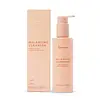What's inside
What's inside
 Key Ingredients
Key Ingredients

 Benefits
Benefits

 Concerns
Concerns

 Ingredients Side-by-side
Ingredients Side-by-side

Water
Skin ConditioningCocamidopropyl Betaine
CleansingCocamidopropyl Dimethylamine
EmulsifyingGlycerin
HumectantSodium Chloride
MaskingSodium Lauroyl Sarcosinate
CleansingSodium Hyaluronate
HumectantGlycosyl Trehalose
Emulsion StabilisingHydrogenated Starch Hydrolysate
HumectantNiacinamide
SmoothingDecyl Glucoside
CleansingSodium PCA
HumectantTremella Fuciformis Sporocarp Extract
AntioxidantLavandula Angustifolia Water
MaskingTrifolium Pratense Flower Extract
AstringentAloe Barbadensis Leaf Extract
EmollientParfum
MaskingWater, Cocamidopropyl Betaine, Cocamidopropyl Dimethylamine, Glycerin, Sodium Chloride, Sodium Lauroyl Sarcosinate, Sodium Hyaluronate, Glycosyl Trehalose, Hydrogenated Starch Hydrolysate, Niacinamide, Decyl Glucoside, Sodium PCA, Tremella Fuciformis Sporocarp Extract, Lavandula Angustifolia Water, Trifolium Pratense Flower Extract, Aloe Barbadensis Leaf Extract, Parfum
Water
Skin ConditioningGlycerin
HumectantSodium Cocoyl Isethionate
CleansingSodium Methyl Cocoyl Taurate
CleansingPotassium Cocoyl Glycinate
Coco-Betaine
CleansingPotassium Cocoate
EmulsifyingPolyquaternium-67
Xylitylglucoside
HumectantCitric Acid
BufferingAnhydroxylitol
HumectantSodium Chloride
MaskingBetula Platyphylla Japonica Juice
Skin ConditioningXylitol
Humectant1,2-Hexanediol
Skin ConditioningGlucose
HumectantSodium Acetate
BufferingSodium Hyaluronate
HumectantButylene Glycol
HumectantTrehalose
HumectantAllantoin
Skin ConditioningChamomilla Recutita Flower Extract
MaskingGlycyrrhiza Glabra Root Extract
BleachingCamellia Sinensis Leaf Extract
AntimicrobialPerilla Frutescens Leaf Extract
MaskingOryza Sativa Bran Extract
Skin ConditioningHouttuynia Cordata Extract
Skin ConditioningCentella Asiatica Extract
CleansingCalendula Officinalis Flower Extract
MaskingDisodium EDTA
Potassium Benzoate
PreservativeWater, Glycerin, Sodium Cocoyl Isethionate, Sodium Methyl Cocoyl Taurate, Potassium Cocoyl Glycinate, Coco-Betaine, Potassium Cocoate, Polyquaternium-67, Xylitylglucoside, Citric Acid, Anhydroxylitol, Sodium Chloride, Betula Platyphylla Japonica Juice, Xylitol, 1,2-Hexanediol, Glucose, Sodium Acetate, Sodium Hyaluronate, Butylene Glycol, Trehalose, Allantoin, Chamomilla Recutita Flower Extract, Glycyrrhiza Glabra Root Extract, Camellia Sinensis Leaf Extract, Perilla Frutescens Leaf Extract, Oryza Sativa Bran Extract, Houttuynia Cordata Extract, Centella Asiatica Extract, Calendula Officinalis Flower Extract, Disodium EDTA, Potassium Benzoate
 Reviews
Reviews

Ingredients Explained
These ingredients are found in both products.
Ingredients higher up in an ingredient list are typically present in a larger amount.
Glycerin is already naturally found in your skin. It helps moisturize and protect your skin.
A study from 2016 found glycerin to be more effective as a humectant than AHAs and hyaluronic acid.
As a humectant, it helps the skin stay hydrated by pulling moisture to your skin. The low molecular weight of glycerin allows it to pull moisture into the deeper layers of your skin.
Hydrated skin improves your skin barrier; Your skin barrier helps protect against irritants and bacteria.
Glycerin has also been found to have antimicrobial and antiviral properties. Due to these properties, glycerin is often used in wound and burn treatments.
In cosmetics, glycerin is usually derived from plants such as soybean or palm. However, it can also be sourced from animals, such as tallow or animal fat.
This ingredient is organic, colorless, odorless, and non-toxic.
Glycerin is the name for this ingredient in American English. British English uses Glycerol/Glycerine.
Learn more about GlycerinChances are, you eat sodium chloride every day. Sodium Chloride is also known as table salt.
This ingredient has many purposes in skincare: thickener, emulsifier, and exfoliator.
You'll most likely find this ingredient in cleansers where it is used to create a gel-like texture. As an emulsifier, it also prevents ingredients from separating.
There is much debate on whether this ingredient is comedogenic. The short answer - comedogenic ratings don't tell the whole story. Learn more about comegodenic ratings here.
The concensus about this ingredient causing acne seems to be divided. Research is needed to understand if this ingredient does cause acne.
Scrubs may use salt as the primary exfoliating ingredient.
Learn more about Sodium ChlorideSodium Hyaluronate is hyaluronic acid's salt form. It is commonly derived from the sodium salt of hyaluronic acid.
Like hyaluronic acid, it is great at holding water and acts as a humectant. This makes it a great skin hydrating ingredient.
Sodium Hyaluronate is naturally occurring in our bodies and is mostly found in eye fluid and joints.
These are some other common types of Hyaluronic Acid:
Learn more about Sodium HyaluronateWater. It's the most common cosmetic ingredient of all. You'll usually see it at the top of ingredient lists, meaning that it makes up the largest part of the product.
So why is it so popular? Water most often acts as a solvent - this means that it helps dissolve other ingredients into the formulation.
You'll also recognize water as that liquid we all need to stay alive. If you see this, drink a glass of water. Stay hydrated!
Learn more about Water